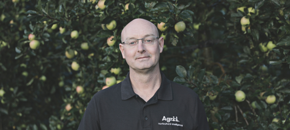Smarter Margins
The Financial Challenges Facing UK Farmers and How to Build Smarter, More Resilient Farm Businesses
Timely insights from the Agrii Tramlines podcast on market pressure, budgeting, local demand, sustainability and marketing strategies to protect margins.
Quick links
- What’s happening to UK farm businesses?
- Why are global grain markets pressuring UK prices?
- How can farmers plan for profit amid volatility?
- What practical steps improve resilience?
- Do sustainability projects improve margins?
- How can marketing strategies manage risk and cashflow?
- Why does communication matter more than ever?
- What Conversations Are Farmers Having About Carbon?
- How Do Farmers Earn and Trade Carbon Credits?
- What Data Should Farmers Focus On?
- What Is the Financial Value of Carbon Credits?
- How Can Farmers Get Involved?
- Are you eager to find out the value of your carbon?
- Where can I learn more about tackling rising costs and smarter margins?
This Episode Features:

Tony Smith
Your Tramlines Host

Lucy Braithwaite-Exley
Scotland Origination Manager - BUNGE

Paul Pickford
Farm Business Consultant
What’s happening to UK farm businesses?
After two exceptionally challenging years for crop establishment and a dry summer, many farm businesses are operating on wafer-thin margins. While the recent autumn finally allowed drilling to progress, market prices remain “nailed to the floor” and costs as a share of output are still too high. As Paul Pickford observes, many arable farms have at best broken even for a second year.
- Low output prices vs. high cost base
- Two seasons of weather-related disruption
- Heightened cashflow pressure at input buying points
Why are global grain markets pressuring UK prices?
Large crops across the Northern Hemisphere and a record US corn harvest have created a bearish global tone. Buyers are purchasing hand-to-mouth as prices drift lower, limiting near-term upside for UK growers. Weather in North China could prove a bullish catalyst if wetness persists and delays plantings and harvests, but for now sentiment remains subdued.
How can farmers plan for profit when so much is out of their control?
A clear, realistic budget and gross-margin plan is still the foundation of resilience. It won’t predict weather or price, but it will:
- Clarify cost of production and target margins
- Expose cashflow pinch points early
- Support lender confidence and access to working capital
In-season, revisit assumptions and adjust spend to protect the final 5–10% of yield and quality where it is economic to do so.
What practical steps can improve farm business resilience?
- Align with local demand: talk to merchants and nearby end-users; minimise haulage drag on margins.
- Grow for a defined market: choose varieties to meet malt, milling or feed specs in your region.
- Use evidence: soil tests, tissue tests and variety disease profiles to fine-tune inputs.
- Adapt rotations: consider OSR, oats or rye where distilling/brewing demand softens; reassess buy-backs.
Do sustainability projects really improve margins?
Yes - when they’re integrated into the system. Programmes such as the Whitworth Sustainability Project and other pilot buy-backs can reward practices like reduced tillage, efficient nutrition and cover cropping. These are not buzzwords; they are practical levers to improve long-term profitability and resilience.
How can marketing strategies manage risk and cashflow?
Structured pools can smooth volatility without fixing a single price in weak markets. Allocating 10–20% of production to a pool secures movement and timely payment while retaining flexibility elsewhere. Pair this with a rolling cashflow to time sales and input purchases deliberately.
Why does communication matter more than ever?
Open dialogue with advisors, merchants and financiers expands your options. Step into the office, review the numbers, and speak early — the sooner conversations start, the more tools are available to steady the ship.
What conversations are farmers having about carbon?
Carbon credits and regenerative farming are becoming critical topics for farmers, focusing on sustainability and profitability. Rising input costs, such as fertilisers, have driven many to explore practices like no-till and cover cropping. While some are actively engaged in trading credits, others remain cautious. Most farmers are now exploring the possibilities, collecting data, and considering their next steps.
How do farmers earn and trade carbon credits?
Farmers begin by establishing a carbon baseline, which involves reviewing field management over the last five years. Once the baseline is set, implementing practices like no-till, cover cropping, and optimising fertiliser use can improve carbon outcomes. These practices are verified through satellite tracking, soil sampling, and independent audits. After verification, farmers receive a report detailing their carbon performance, providing the option to trade or retain their credits.
What data should farmers focus on?
Farmers should concentrate on three key areas: fuel usage, fertiliser efficiency, and soil health. Minimising cultivation passes and optimising spray applications reduces fuel consumption. Fertiliser strategies should focus on ensuring nutrients are used efficiently, potentially through organic manures or inhibitors. Soil health improvements, such as boosting organic matter, not only enhance resilience but also unlock financial incentives like payments under the Sustainable Farming Incentive (SFI).
What is the financial value of carbon credits?
The average UK farmer earns around £33 per hectare from carbon credits, with values ranging from £20 to over £50 per hectare. Practices such as reducing tillage, adopting cover crops, and leaving straw on fields significantly increase credit value. By stacking carbon income with schemes like the SFI, farmers can replace a significant portion of lost Basic Payment Scheme (BPS) revenue while maintaining production.
How can farmers get involved?
Getting started with carbon credits is straightforward. Farmers can register their interest with their Agrii agronomist or through an event. Agreena's team will then guide them through the process, including data collection and potential carbon valuation. This step-by-step support ensures that farmers can easily integrate carbon credit generation into their operations.
Are you eager to find out the value of your carbon?
Register for a free estimation by visiting this link and one of our team will be in touch.
Where can I learn more about tackling rising costs and smarter margins?
For deeper analysis, download Agrii’s latest Insight Report: Beyond the Bottom Line — Tackling Rising Costs with Smarter Margins.
Related episodes
Gain with Grain: Sustainable Solutions from Agrii, Viterra & Whitworth
Episode 1Building Crop Resilience to Protect Yield
Episode 13Resilient Farming in Action
Episode 7A Plain English Policy Update with AIC, AHDB and Agrii
Episode 6The Reality of SFI: Part 2 - The What, Where and How?
Episode 19Scottish Farming in Focus: Seasonal Advice from Bee Edge Farm
Episode 17Smart Nutrition: Maximising ROI on Phosphate, Potash & Nitrogen
Episode 18Maize Matters: Ensure your variety selection is in Harmony
Episode 16Tramlines 2024 Wrapped: Key Podcast Takeaways for 2025
Episode 14Never miss an episode of Tramlines








